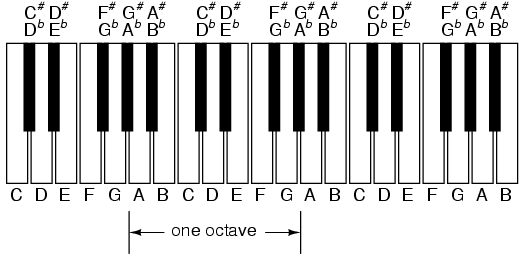« Atlas Shrugged | Main | Poaching Christmas »
December 12, 2008
Missing Piano Keys

I've never understood why a piano keyboard has less black keys than white keys. Now, for clarification, I know nothing about music. True - I took piano lessons for 6 years and played the trumpet for 4 years, but I got a degree in Mathematics and I know nothing about math. So, trust me when I tell you I know nothing about music.
But it strikes me as odd that some of the piano keys have sharps and flats, but not all of them do. For instance, the C key has a sharp, but not a flat. Likewise, the B key has a flat, but not a sharp. Most of the white (natural) keys on the piano have a black key in between them, but there is no black key between the B and the C, nor is there a black key between the E and the F. Why is this?
I assume that flats and sharps are about 1/2 of the frequency difference between the two white (natural) keys on the keyboard. So why is there no black key between the B and the C and between the E and the F? I think it would stand to reason that there is no such note (on a piano, at least) as an E Sharp, F Flat, B Sharp, or C Flat. Why is this? Would these two frequencies sound so horrible that it would make humans cringe?
This post on the history of the piano is about the history that I'd expect most idiots to offer and accept. Mindless sycophants handing down the same babble they've been fed at some point along the line. Mindless dolts too dumb to ask the less obvious questions. They explain that the first pianos and organs only had the 7 natural(white) notes and did not have the black (accidental) notes. But later, 5 accidental notes were added to the 7 keys for a total of 12. Brilliant. But still, they fail to address the pressing question - why are there not 7 accidental notes? Arrrgh.
I found this post which shows the corresponding frequency for each piano key in a hypothetical, idealized piano. I loaded the frequencies into Excel and calculated the difference between each note, but I was surprised to find that frequency difference wasn't constant. So, I've got to do more research, obviously.
This post says the following:
C flat and F flat sound (using what's called equal temperament) the same as B and E, so there was no need for additional notes.
It's ultimately to do with the physics of music, and an interesting little feller called the Pythagorean Comma.
For more information, try the wikipedia entry
en.wikipedia.org/wiki/Diatonic
I looked up the Pythagorean Comma and although I'm no closer to finding the missing piano keys, I am starting to get some clue as to how the notes and octaves are based on fifths. The pitch ratio of a perfect fifth is 3:2.
Posted by Rob Kiser on December 12, 2008 at 11:38 PM
Comments
"I've never understood why a piano keyboard has less black keys than white keys."
racism
Posted by: al #ton on December 13, 2008 at 6:57 AM